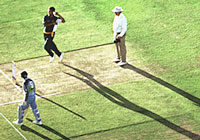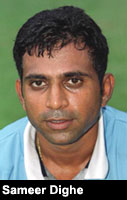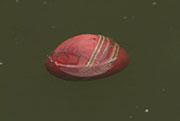 Home > Cricket > Diary archives
Home > Cricket > Diary archivesSeptember 3, 2001
It's all Greek to us
Prem PanickerWas it the Greek general Pyrrhus who once said, "One more victory like this will ruin us"?
He was referring to a war with the Romans -- but he could just as well have said those words at the end of the recent home series against the Australians, which ended in a 2-1 series win for India.
The win was taken, at the time, as an indication that Indian cricket had turned the corner -- and I must confess to being guilty to subscribing to that view, just like pretty much everyone else. The prevailing feeling was that the team had finally completed the churning process, that the amrit had been collected and moulded into a set of 11 players who would do the country proud in the coming season.
One more victory like that would, to quote Pyrrhus, have ruined us completely. Which is why, 24 hours after watching the team lose the three Test series to Sri Lanka, I find myself rather glad about the result.
Had India won the series in Sri Lanka, everyone -- including, I suspect, myself -- would have been so busy celebrating the 'first overseas win since the time of Methusaleh' to be in a mood to take a long, hard look at the side and its component parts.
Thanks to the defeat, that look will hopefully now be taken -- better now, than in the period October-through-December, which will see the 'boys' play a hard series against South Africa on the fast tracks that country will undoubtedly produce, and then fly back home to take on England just five days later.
And while we are on the subject, it might be an idea to look at the team, and its support system, not in the limited perspective of the Protean tour now looming. If there is any introspection with a view to change, then the sights need to be set much further ahead -- say, with a view to making this a competitive, hard-fighting outfit by end 2003 (and that, by the way, is an estimate that errs on the side of optimism).
For too long now, we've been administering cricketing bandaids to our wounds. Opener failed? Dump him, pick another, if he fails, lots more where they came from. Middle order sucks? Drop a couple of the fringe players and take a couple others. Team lost, no one to really blame? Cool, axe the captain. We have tended to live life series by series -- and that limited mindset has produced only a team that is consistent only in its inconsistencies.
From a long range point of view, thus, this tour has been full of lessons for the team, and for its administrators. And to begin at the beginning, lesson one is the tracks.
 The green green grass of home: For most part of the last decade, we've been talking of creating fast, well-grassed tracks in India. The idea, board officials sanctimoniously said, was to ensure that the team was not caught on the wrong foot when it went abroad and found itself playing on a greentop.
The green green grass of home: For most part of the last decade, we've been talking of creating fast, well-grassed tracks in India. The idea, board officials sanctimoniously said, was to ensure that the team was not caught on the wrong foot when it went abroad and found itself playing on a greentop.
Till date, though, we haven't ever walked that talk. We've created a pitches committee -- headed at various times by the likes of Kapil Dev and Krish Srikkanth. We've invited soil experts from New Zealand to lecture our groundsmen on how to prepare good fast wickets. But each time we had a home series, it was the same old story -- of groundsmen employing tooth and claw to excise every single blade of grass from the playing area because the team management insisted on turning tracks.
Sri Lanka came as a startling contrast -- the pitches at Galle and Kandy were well grassed and even the SSC deck, for the third Test, had live grass on it. Lanka in fact has for some time now been content to leave grass on its wickets, for both domestic and international competitions. Call it coincidence, if you like, but in the recent past, the Lankan batsmen have begun handling fast bowling with relative ease and, equally, the side has been turning out quality seam bowlers. Check out the contrast -- India at the end of the series is talking about Ashish Nehra being injured and Zahir Khan playing at below his best physical form. Sri Lanka, meanwhile, does not even murmur about the absence of Nuwan Zoysa, Ravindra Pushpakumara and others, but wheels out Dilhara Fernando and Ruchira Perera.
More to the point, in the recent past, Sri Lanka felt confident enough to leave some grass on its tracks against South Africa -- and ended up with a squared series. Whereas India opted for turning tracks in its last home series against the same country -- and what did we get?
What we got, was a situation where we are increasingly forgetting how to play spin (23 wickets to Muralitharan in three Tests? Two five wicket hauls?) while not learning to play pace. We've also got a situation where, with Srinath losing his sting and Nehra injured, we suddenly find that we have no viable pace options. And if this trend continues, then we are heading towards where we will do well neither at home nor away.
Sri Lanka has climbed to fourth place in the international Test rankings -- and we have slipped to eighth. To me, that shows the positive effect of long range planning by the one team, and the lack of it in the other.
Spare strings to the bow: I'm frankly a touch tired of reading how Sachin Tendulkar and VVS Laxman were not on the Lankan tour, thus qualitatively devaluing our middle order. Let's play worst case scenario: Suppose Sachin and Laxman never come back, what then? Do we then say that we don't have a viable middle order, and give up playing cricket?
You have to remember, too, that Sourav Ganguly and Rahul Dravid are bucking a trend, in going as long as they have without needing to take an injury break. Sourav has recently complained of an abdominal strain which needs immediate attention. What if those two are also rendered hors d'combat? Do we have Plan B?
Whatever happened to our second string, anyway?
The short answer is, we don't have one because we have not bothered to develop one. Time and again, the selectors talk of the depth of talent available to us -- but the proof of that particular pudding lies in the fact that we have now gone 5 Tests (including two in Zimbabwe) without a single Indian centurion -- the last 100 against an Indian name was Sachin's 126 in Chennai against Australia.
Never mind centuries, in this same span of time, the middle order has collapsed time and again, on occasion despite being given sizeable starts by the openers.
In this connection, it is interesting that the BCCI has recently permitted the New Zealand A team to play in the Buchi Babu tournament here. Which is good for the Kiwis, since it gives their second string players an opportunity to hone their skills and ready themselves for the moment in time when they might have to step into the shoes of the seniors. But what does that get us? Should the board not have worked out a reciprocal arrangement whereby the India A team plays in the Kiwi domestic circuit? Shouldn't we be organising as many 'Tests' for the A team as for the seniors?
We haven't. And we won't -- because A team programmes involve expenditure, without corresponding income. But is it all about dollars and cents? The Indian cricket team earns big money for the board, year in and out -- should the board not be spending a part of that money to ensure that there will be an Indian team that can put warm bodies in the stands, even if Sachin, Rahul, Sourav and Laxman are simultaneously injured?
Bring back Kirmani: On the face of it, it might seem unfair to blame the wicket-keeper for the problems of the team, but look a bit deeper, and you'll see just how badly we are hurting in this department.
Samir Dighe produced one fighting innings against Australia that helped win us a Test. And that is it -- neither before, nor since, has be been a contributor with the bat.
 A wicket-keeper who can contribute 20, 30 runs with the bat is vital for an Indian team that is struggling to post sizeable totals. So check this out: In three Tests versus Lanka, Dighe played 5 innings, totalled 44 (with a top score of 28, so the other four innings yielded 16), and averaged 8.8. Against this, his counterpart Kumar Sangakaara played four innings -- in the number three slot, mind you -- was not out once, aggregated 196, and had an unbeaten century to his name, to average a hefty 65.33.
A wicket-keeper who can contribute 20, 30 runs with the bat is vital for an Indian team that is struggling to post sizeable totals. So check this out: In three Tests versus Lanka, Dighe played 5 innings, totalled 44 (with a top score of 28, so the other four innings yielded 16), and averaged 8.8. Against this, his counterpart Kumar Sangakaara played four innings -- in the number three slot, mind you -- was not out once, aggregated 196, and had an unbeaten century to his name, to average a hefty 65.33.
Sangakaara and his predecessor, Romesh Kaluwitharana, are Lanka's all-rounders, contributors with both bat and ball. India, for its part, has had an all-round failure -- the above figures sum up his batting, and an expression of shock would sum up his keeping throughout the series, with his performance in the third Test hitting rock bottom. With Lanka chasing 234 in the third Test and losing Jayasuriya early, Dighe missed a simple stumping off Sangakarra and a caught behind off Jayawardene -- and between them, those two batsmen added just over 200 runs after their reprieves.
Back home in India, we have at least two young keepers in Ajay Ratra and Deep Dasgupta, both of whom are good batsmen as well. Ratra could do with a year or two more to hone his glovework, but Dasgupta is as ready as he will ever be. The Indian bowlers, in fact, acknowledge that he is good -- and with the bat, he has a rock-solid defence and an ability to make his crease-time productive.
And what is more, both are young. Very young. Which means that if even one of them settles down to the job, then that is one worry solved for the foreseeable future.
How much does a ball cost? Aren't you tired of hearing how the Kokkaburra balls in use in Lanka made a difference to Indian bowlers used to bowling with Dukes (sort of like our hockey team that through the eighties and part of the nineties, practised on grass and lost on astroturf).
Fair enough, Dukes has a more pronounced seam, making it easier to grip. Also, the Dukes seam stays hard, so that spinners have something to work with as the ball goes older, while the Kokkaburra seam softens and merges with the surrounding leather, so that a Harbhajan, say, finds that he is bowling with what almost amounts to a billiard ball.
But when did the team, its management, and the board find out that Kokkaburra balls would be in use -- on the final day of the third Test?
They use that make of ball in Australia, in South Africa, in Sri Lanka and elsewhere. Everyone knows this. What we don't know is how much longer it will be before someone wises up to the fact that the BCCI needs to procure large quantitites of Kokkaburra balls and ensure that the Indian team uses them regularly for practise.
I mean, how much does it cost to buy a cricket ball?
 We could dig up all kinds of statistics to show what went wrong in Lanka: Lack of thought on the first morning in Galle, that allowed an out of form Jayasuriya to blast his way to a century that took the game away from us; lack of the application necessary to play the game session by session, as evidenced by the number of times the team went through one or two sessions without losing more than a wicket or two, and then gave it all away with three, four going down towards the end of play; lack of synergy between the batsmen in that they rarely if ever built successive, and good, partnerships; lack of understanding between batsmen in their calling and running (three run outs in one innings at the SSC?) which speaks of lack of practise in this department; lack of a bowling spread which meant that if one bowler had an off day, there was no one left to step into the breach; a 'keeper who couldn't keep; a collective inability to build on starts and go on to make the big scores (at the SSC, for instance, four Lankan batsmen made centuries, three of them after being reprieved -- whereas both Indian openers crossed 40, two other top order players crossed 30, and yet not one of them could go on to play a sizeable innings)...
We could dig up all kinds of statistics to show what went wrong in Lanka: Lack of thought on the first morning in Galle, that allowed an out of form Jayasuriya to blast his way to a century that took the game away from us; lack of the application necessary to play the game session by session, as evidenced by the number of times the team went through one or two sessions without losing more than a wicket or two, and then gave it all away with three, four going down towards the end of play; lack of synergy between the batsmen in that they rarely if ever built successive, and good, partnerships; lack of understanding between batsmen in their calling and running (three run outs in one innings at the SSC?) which speaks of lack of practise in this department; lack of a bowling spread which meant that if one bowler had an off day, there was no one left to step into the breach; a 'keeper who couldn't keep; a collective inability to build on starts and go on to make the big scores (at the SSC, for instance, four Lankan batsmen made centuries, three of them after being reprieved -- whereas both Indian openers crossed 40, two other top order players crossed 30, and yet not one of them could go on to play a sizeable innings)...
These last few factors could be addressed, and to an extent rectified. And given that every now and again we produce individual performances of rare brilliance, we will probably win a Test, or even a series. Probably even against the odds. But as that Greek chappie said long ago, a few more of such victories could completely ruin us. What we need -- and got, in Lanka -- is a sobering defeat, to remind us of the need for long range thought, and planning.
Previous diary:It's black and white
The Rediff Email Diary -- the complete archives
![]()
![]()
Email : Prem Panicker
©1996 to 2001 rediff.com India Limited. All Rights Reserved.